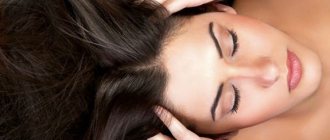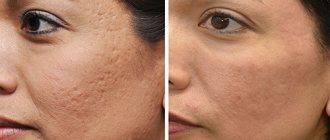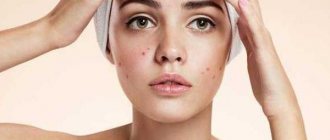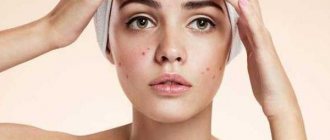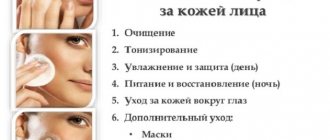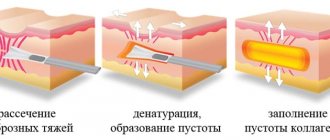Redness on the face - why it appears
Brief redness on the face is usually not a sign of health problems. In this way, healthy skin reacts to temperature changes, physical activity, stress, alcohol consumption and other unusual situations. The main thing is that a healthy body quickly copes with this and after a few minutes the complexion returns to normal.
If red spots on the face appear regardless of the emotional state or external factors, then you should think about undergoing a full examination by a doctor.
Common causes of redness on the face:
- The body's reaction to citrus fruits (lemons, oranges, tangerines, etc.);
- Excessive tanning without the use of protection;
- Eating sweets or foods high in sugar;
- Reaction to cosmetics or hygiene products.
However, sometimes red spots appear on the face, seemingly for no apparent reason. In this case, it is important to visit a doctor and identify the exact cause of their occurrence. It is dangerous to take any measures without consulting a professional.
In addition to the above reasons, redness on the face can also be a reaction to the following irritants:
- Allergic reactions. An allergy can appear to anything and at any age, even if it has never existed before.
- Inflammation. Facial skin is delicate and sensitive, so damage to it can cause inflammation.
- Food. Too sweet, salty or simply fried can cause a reaction on the face.
- Vascular reaction. Vessels may dilate after physical exertion, alcohol, severe coughing or laughter, or a sudden change in temperature (for example, in a bathhouse, sauna).
In most cases, redness on the face is not a serious pathology and can be easily treated.
Why does the skin turn red?
Persistent vasodilatation (rosacea) may be genetically determined, but there are a number of factors that can lead (and lead) the skin to this condition. These factors can be divided into exogenous, that is, caused by the external environment, and endogenous, those that are an internal problem. The first includes the improper use of cosmetic products ─ creams and ointments (preparations with a hormonal component, when used for a long time, can cause so-called “rosacea”). The use of strong peels and laser treatments can also cause permanent capillary dilatation, especially in people with fragile blood vessels. Frequent visits to saunas, prolonged exposure to the sun and cold for those with sensitive skin are also risk factors. Endogenous causes include: malnutrition, varicose veins and other diseases associated with the cardiovascular system. Endogenous reasons include a special subtype of skin itself - hypersensitive and difficult to tan.
Cuperosis can also be a consequence of rosacea, and in this case, you need to figure out what triggered the disease and prescribe appropriate therapy (red mesh marks can be erased from the face using laser procedures aimed at thermal adhesions of dilated blood vessels).
How to remove redness on the face
How to get rid of redness on your face by following a few simple rules:
- Proper nutrition. What a person eats is immediately reflected on his skin. You should not abuse coffee and unhealthy fatty foods; it is better to switch to natural herbal teas. Also, do not eat food too hot. This increases sweating, which is harmful to your facial skin.
- The right tan. Even with a simple walk outside in the summer, you should not forget about sunscreen. Excessive sun exposure is harmful to all skin.
- Strengthening blood vessels. The vessels on the face should always be in good shape. To strengthen blood vessels, you can use specialized gels, for example Escin.
- The right cosmetics. It is important to use anti-redness cream on the face and cosmetics and face wash products that are compatible with your skin type.
It is important to properly cleanse the skin, tone and moisturize. The main thing is not to use aggressive components, silicones and fragrances - so as not to provoke facial irritation.
Products that can be considered as care products for sensitive skin include:
1. Cleansing - Cleansing foam with plant enzymes ResedaOdor. The product has a soft structure and does not contain aggressive components, alcohol, flavors or dyes. Contains plant enzymes from pomegranate and pumpkin. They act as a soft natural peeling. Without tightening or drying out the skin.
Foam with plant enzymes ResedaOdor, cleansing
2. Toning – ResedaOdor Restoring skin toner, 250 ml. Contains a combination of northern plant extracts. Does not contain alcohol, dyes or flavors. Suitable for dry, normal and sensitive skin.
ResedaOdor Restoring skin toner
3. Moisturizing - ResedaOdor rich cream for deep skin hydration. The cream is specially created to deeply moisturize the skin. low molecular weight hyaluronic acid acts in the deep layers of the epidermis. Relieves irritation, restores the hydrolipid layer and protects the skin from external influences. Also contains spf 6.
ResedaOdor cream, rich, deep skin hydration
Clinical researches
The effectiveness, safety and tolerability of La-Cri products have been clinically proven. The products are recommended by the Union of Pediatricians of Russia. During clinical studies, specialists were able to record impressive results.
It has been proven that La Cree cream for dry skin:
- eliminates dryness and flaking;
- retains the skin's own moisture;
- protects skin from wind and cold.
In addition, it has been clinically proven that La Cree cream for sensitive skin:
- reduces itching and irritation;
- relieves skin redness;
- moisturizes and gently cares for the skin.
Sources:
- Baumann Leslie, Cosmetic Dermatology. Principles and practice, MEDpress-inform, 2016.
- Ratner Desiri, Avram M.R., Avram M.M., Procedures in Dermatology. Clinical cosmetology, GEOTAR-Media, 2022.
- Sukolin Gennady Ivanovich, Clinical dermatology. A short guide to the diagnosis and treatment of dermatoses, Notabene, 2017.
How to remove irritation on your face
The cause of redness is irritation, which is a constant companion of sensitive skin. For this type, it is important to constantly use a cream for skin irritation on the face. You can try several options and choose the most suitable one.
How to get rid of irritation on your face with daily care? When washing, the water should not be too cold or hot. The optimal water temperature will be approximately equal to body temperature – 36-40 degrees. It is important to apply the cream after each wash in the morning and evening.
As an additional care, we recommend using Monomolecule No. 17, which helps reduce irritation caused by: UV rays, immune reactions, exposure to external factors and mechanical stress. Affects the nervous system of the skin, improving its condition.
Monomolecule No. 17 anti-stress for sensitive skin ResedaOdor
Sensitive skin is one of the main types, which is characterized by an excessive response to physical, chemical, and hormonal factors. Sensitive skin shows signs of irritation, redness, peeling, and rashes. This type requires agents that act on nerve endings and suppress the activity of substances that trigger inflammation.
Monomolecule No. 17 is an ideal assistant. It belongs to neurocosmetics. These are cosmetics whose ingredients are able to penetrate the stratum corneum and influence specific structures of the nervous system.
Ingredients
Water, Butylen glycol, Dextran, Palmitoyl-tripeptide-8.
How to disguise
When redness cannot be removed, it can be hidden. Here you need to remember that pink and peach tones only aggravate the situation. Focus on the shade of the skin on your neck - it is according to this that you need to select a foundation. Are you worried about local redness? You can get by with a yellowish and slightly earthy-toned corrector (but without pink pigment in the composition!). If you cannot imagine life without powder, apply it to the skin with a brush or puff with light patting rather than stretching movements.
Face masks for redness and irritation of the skin
When answering the question of how to get rid of redness on the face, it is worth mentioning masks. Special masks are good for removing redness from the skin of the face. They must contain ascorbic acid, which is one of the most important vitamins for the body. In addition to vitamin C, the mask should contain moisturizers that will soothe the skin. One of the best moisturizing components is polymarin.
Dealing with redness on your face is easy. To do this, you must follow the rules of care and use cosmetics suitable for your specific skin.
How to treat
If the reason is not a vegetative reaction, but dilated blood vessels, the problem can and should be dealt with. There are several methods, and among the most popular are laser therapy and photo exposure. The doctor gives preference to one method or another depending on the specific case. Phototherapy can be considered a more gentle option (plus it also fights pigmentation). Lasers, in turn, are less friendly, but are more effective at removing highly visible blood vessels.
You can’t expect complete help in eliminating rosacea from cosmetic products, so it’s better to rely on them to reliably protect the skin and prevent redness. The composition of such cosmetics should include the following components: amino acids, oils with saturated fatty acids, urea, chitosan, hyaluronic acid. Vitamin C and troxerutin, which help strengthen the walls of blood vessels, will also not hurt. One caveat: knowing the ruddy characteristic of your skin, try to use professional cosmetics that are effective and efficient. There is a taboo on cosmetic preparations with aggressive acids, which can aggravate the redness process, “hard” peels and laser dermabrasion.
Redness of the eyes due to a hangover
Often facial swelling after alcohol is not the only symptom of a hangover. Bags under the eyes and redness are also consequences of alcohol abuse. Eye drops that constrict blood vessels will help here. However, we must remember that their action provokes an increase in intraocular pressure, and the feeling of discomfort is not removed. Recommended eye drops:
- Visine;
- ophthal
- tetrizoline;
- vial;
- vitoptik and others.
It should be borne in mind that deterioration in appearance is not the worst consequence of excessive alcohol consumption. Very often, alcohol provokes or aggravates a serious illness. It is not always possible to recognize alarming symptoms in time, so it is important to be attentive to all the signals that the body sends.
What causes involuntary shaking (tremor)?
Chronic alcoholism occurs with certain symptoms, including tremors of the head, hands, and tongue. This is an involuntary small trembling that tends to intensify in the morning and on an empty stomach. In some cases, after eating or drinking, the tremor disappears, so alcoholics cannot do without a hangover. At the same time, a person without alcohol dependence in a state of hangover experiences an aversion to alcohol (to the smell and sight).
Do not confuse small and large tremor. The latter affects the entire body and most often occurs after a single excessive use of alcohol. It does not indicate the development of addiction, but indicates acute poisoning. This requires urgent removal of harmful products from the body through detoxification. It is recommended to consult a doctor for advice on effective ways to eliminate toxins.
Hormonal and neurogenic factors
Estrogens influence the sympathetic nervous system by acting on 2-adrenergic receptors, which leads to vasospastic reactions. Starting from a certain age (about fifty years), the production of estrogens and progesterones decreases in the female body. This condition is very often accompanied by a feeling of heat, temporary, sometimes long-lasting facial hyperemia.
In general, vasospastic diseases and reactions (Raynaud's phenomenon) are more common in women and are more common during the reproductive period. During pregnancy, a decrease in the vasospastic readiness of facial skin vessels is often observed. Microcirculation in the facial skin varies throughout the menstrual cycle.
Digestive diseases
Diseases of the gastrointestinal tract can indirectly affect vascular health. Irritation from the mucous membrane of the gastrointestinal tract is transmitted through the branches of the vagus nerve to its nuclei, the excitation passes to the nearby nuclei of the trigeminal nerve and through the branches of the latter enters the central zone of the face, causing vasodilation.
Recent studies confirm that the bacteria Helycobacter pylori persisting in the gastric mucosa contributes to the disruption of neurochemical regulatory mechanisms, which in turn lead to vasodilation.
Exaggerated blushing
A person susceptible to blushing experiences only two problems: the appearance of a ruddy complexion and the reaction of others to this. As numerous studies say, the second problem is the most serious, because the scarlet color confuses a person, and he tries to hide it or even get away from his interlocutors. This entails problems with society, because the situation calls into question communication with peers. In this case, social phobia develops.
Such behavior is wrong, since in any case the attitude of others towards the issue raised is unknown; maybe they don’t care or they like it. A good solution to this problem would be to ask your social circle how they feel about blushing when talking. The answers will differ from those expected. Indeed, in ninety-nine percent of cases, blushing only decorates the appearance, making it more prettier.
